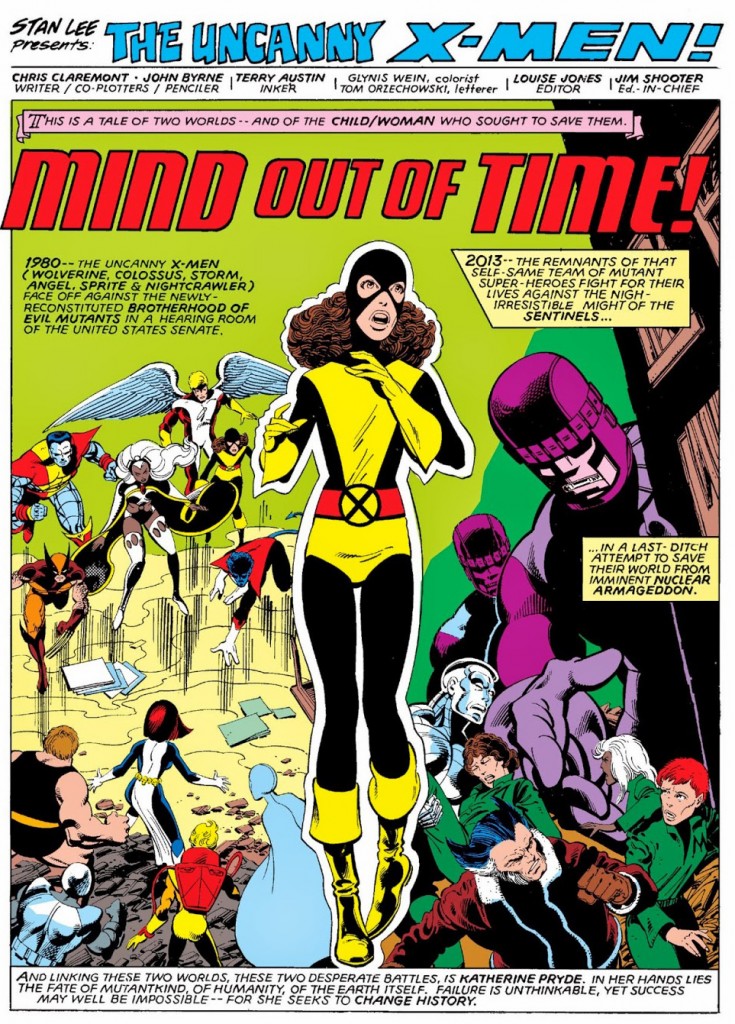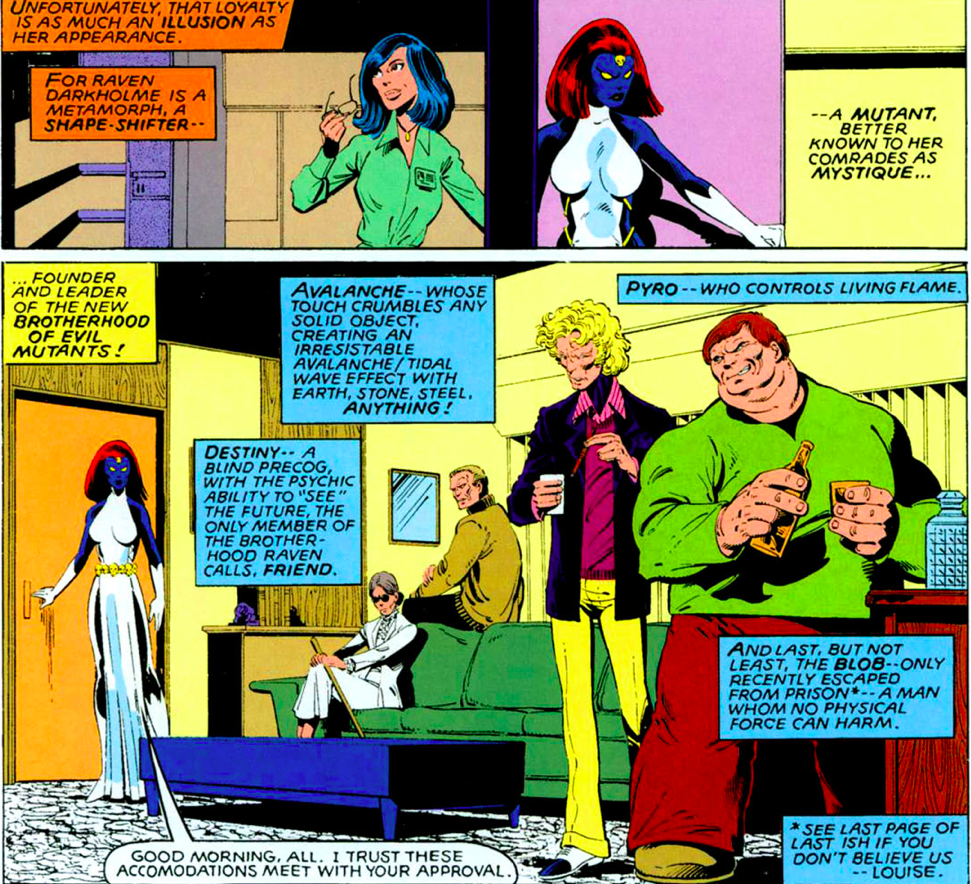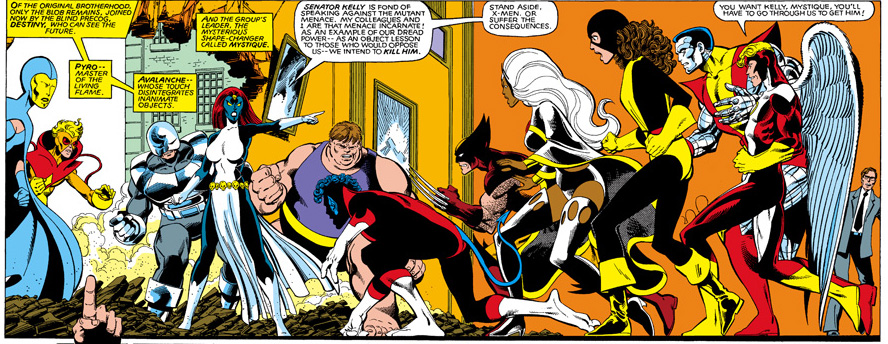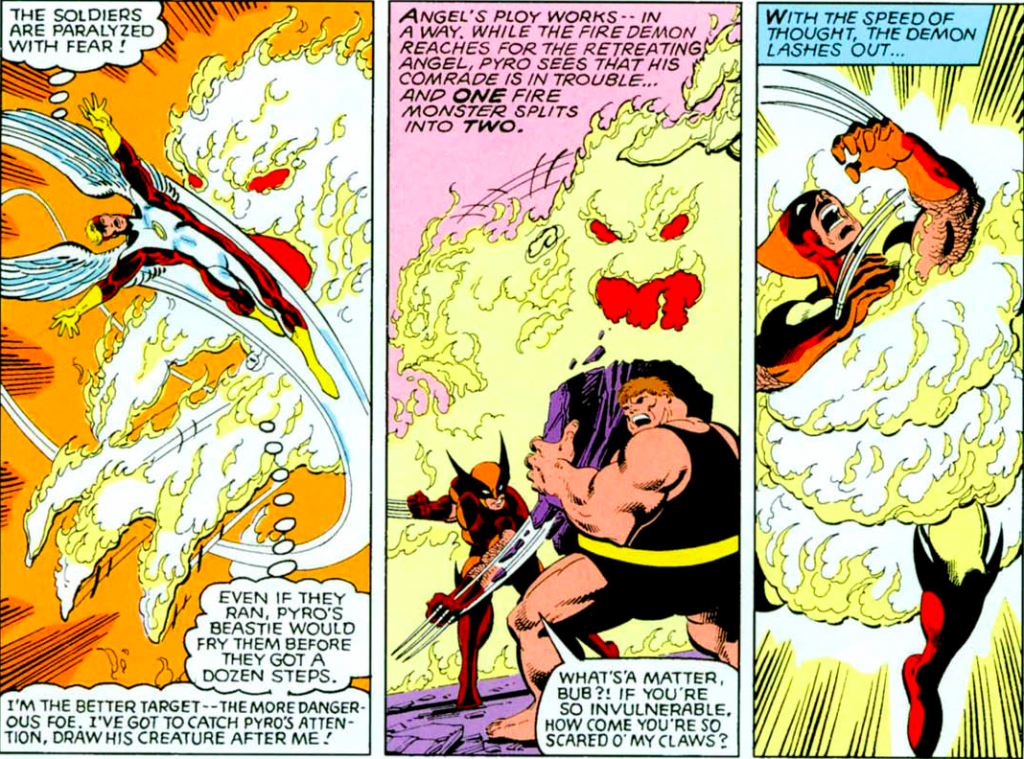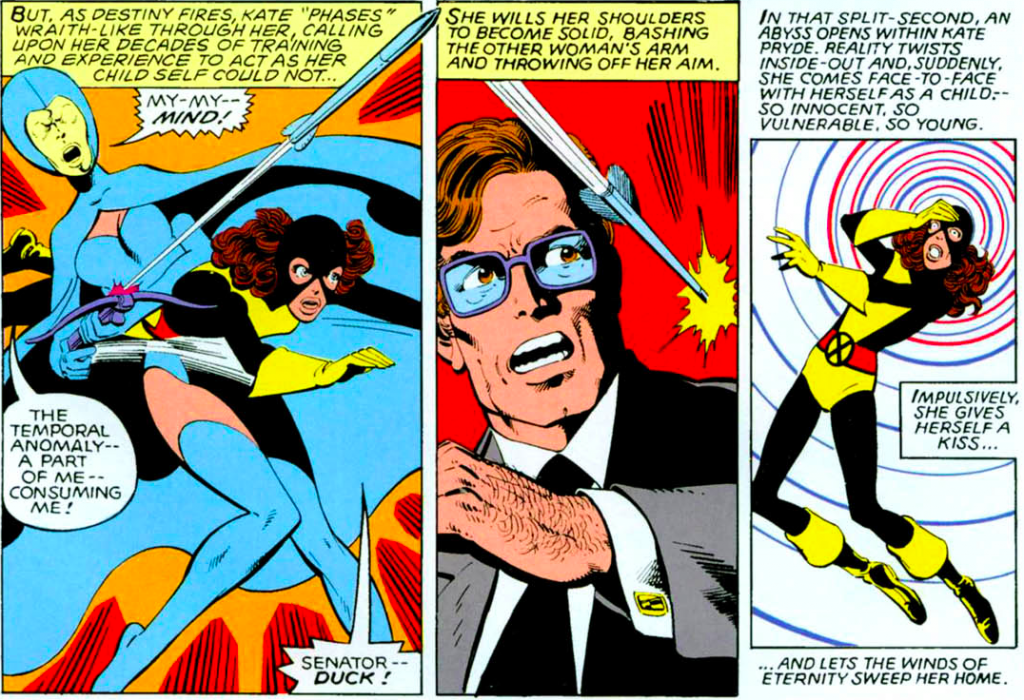With the release of the first X-Men film in 2000, audiences not only witnessed the dawn of the modern day superhero film boom, but also the beginning of a complicated franchise that would span sixteen years and nine films. With X-Men: Apocalypse on the horizon, Kayleigh Hearn and a rotating cast of merry mutants are revisiting the X-Men films from the very beginning, and examining the comic book storylines that inspired them. What would you prefer, yellow spandex?
Uncanny X-Men #141-142, “Days of Future Past” (1980)
By Chris Claremont and John Byrne
Kayleigh: Days of Future Past probably doesn’t need an introduction, but here’s one anyway! Published only a few months after the The Dark Phoenix Saga‘s shattering conclusion, Claremont and Byrne took us to the far-flung future of 2013, where Sentinels have conquered the world and only a handful of mutants survive. The telepath Rachel Grey sends Kate Pryde’s mind into the body of her younger self to prevent Mystique and the Brotherhood of Evil Mutants from assassinating Senator Robert Kelly. The X-Men would never be the same, because, for one thing–they all die!
Dylan: I’m sure Days of Future Past was a hit with readers when it was first released, but it’s truly fascinating in hindsight, for a couple of reasons. For one, it’s the beginning of the X-Men’s long, tumultuous history with time travel and alternate timelines, which have become an enormous part of the franchise. I imagine this arc came totally out of left field in 1980, but by the 2000s this kind of thing had become the X-Men’s bread and butter. The other crazy thing about Days of Future Past looking back is that it was only a two-issue arc, whereas if it were made today it would probably have been fodder for a ten-issue miniseries. (Come to think of it…)
Kayleigh: Claremont’s ultra-compressed plotting strikes again! So much happens in these two issues! Even beyond the well-known time-travel plot, these two issues also introduce classic X-Men characters Rachel Grey, Avalanche, Pyro, and Destiny, and it seeds long-developing plotlines like Magneto’s redemptive arc, Kitty and Piotr’s romance, and has the very first hint that Mystique is Nightcrawler’s mother. Talk about getting your 50 cents’ worth! I actually first read Days of Future Past when it was adapted into an illustrated children’s book in the ’90s—and it was a surprisingly faithful novelization, considering the super dark subject matter. And yet it’s really one of the definitive Kitty Pryde stories, as she represents hope and the possibility of change even in the face of Armageddon. I don’t know how you can read these issues and not love her.
Dylan: It’s funny you should say that, because while Kitty Pryde is generally my favorite X-Man, re-reading this story I couldn’t help but wonder if Chris Claremont wasn’t trying a little too hard to sell his new pet character to readers. Kitty’s been an X-Man for only a couple of issues, and already she’s saving the future! Yes, the idea that it’s really grown-up future Kate who’s the super-competent badass while present-day Kitty is the starry-eyed rookie mostly redeems this power play, but I couldn’t help but catch a whiff of Eau de Wesley Crusher off of this book. (And seven years before TNG, to boot!)
Kayleigh: These comics were published before I was born, but I’d hazard a guess that an innocent thirteen-year-old girl with a passive power joining the X-Men in 1980 was a bit of a hard sell for some readers. I think Claremont and Byrne do a good job of establishing Kitty as a fresh new face. She’s cute and spunky and relatable, well before Claremont got a little too precious and established her as a ballerina/ninja/computer genius.
Dylan: I actually found myself more invested in the way Days of Future Past shows Storm settling into her new role as leader of the X-Men after Cyclops’ departure. The X-Men are, at face value, a much better team than the new Brotherhood, being made up of compassionate characters who have trained together for quite some time, while the Brotherhood are a bunch of miscreants who barely get along. And yet, the Brotherhood seem to have the edge in this match-up because of the cunning leadership of Mystique, who always seems two steps ahead. Storm just doesn’t have as tight a grip on her teammates yet, something she learns the hard way when she butts heads with Wolverine over his displays of force on live television.
Kayleigh: These are great comics to point to if anyone is looking for examples of Claremont writing powerful women. All the major players in this story are women: Kitty, Rachel, Storm, Destiny, Mystique…It’s very interesting to compare comic Mystique to Jennifer Lawrence’s Mystique, since both have very different takes on the would-be assassin.
Dylan: Mystique has developed into a very complicated character in today’s comics world, but here she’s just a straight-up badass supervillain, a formidable opponent for the X-Men and a worthy successor to Magneto for leadership of the Brotherhood. J-Law’s version, for whatever reason, just comes across as weak and boring despite doing a bunch of really cool stuff throughout the film! She saves a quartet of mutants in Vietnam, she does a bunch of cool super-spy stuff while on a quest for justice and revenge–she’s basically filling the role that Magneto played in First Class, but while Fassbender’s performance was twisted fun, Lawrence’s Mystique is just blank and sad the whole time. Comics Mystique isn’t mopey, she’s In Damn Charge.
Kayleigh: The film version of Days of Future Past plays Mystique as a much more ambiguous character, which is understandable since the plot hinges on whether or not she can kill Trask. I think Lawrence’s performance is fine, and I welcome the character development that Rebecca Romijn’s Mystique never got. Less interesting is the idea that Magneto and Xavier are “battling” for Raven’s soul, though at least the ending has Raven leaving them both behind to find her own way.
Comics Mystique sure as hell isn’t defined by her relationships with men, and though her characterization here isn’t very nuanced (they were the Brotherhood of EVIL Mutants, after all) you know she fucking means business. Her relationship with Destiny is only briefly hinted at, but it’s one of my favorite romances in superhero comics. Disappointing that the movies have never introduced Destiny or even alluded to Raven’s bisexuality.
Dylan: As for Rachel Grey, her appearance here is extra cool because we don’t get her last name, but she’s a telepath with red hair and so there’s just this little hint that maybe she’s got something to do with Jean Grey. And she doesn’t come back into the picture for a good year or so, when we discover that her efforts to change the past did nothing to save her future–an outcome that’s even teased in a line of dialogue toward the end of DoFP! Talk about the Claremont Long Play.
Kayleigh: We only get the barest hint of who Rachel is and what she has the potential to be–it’s interesting to compare Rachel and Kitty’s relationship here with Claremont’s X-Men spinoff Excalibur, which is cartoonish, goofy fun and wildly different in tone from the grim future of Days of Future Past. Though, since you mention the tease at the end that suggests the timeline wasn’t changed, apparently that bit was one of the final nails in the coffin for the Claremont/Byrne partnership. Byrne wanted this story to end with an unambiguous “win” for the X-Men, but Claremont’s script invalidated that interpretation.
Dylan: There are some moments in this story where I felt like Claremont was getting in the way of Byrne’s visual storytelling. There’s a panel in which Pyro is clearly grabbing Angel with a big hand made out of fire, and Angel is like “Oh, no! Pyro is totally grabbing me with a big hand made out of fire!” and I couldn’t help but roll my eyes. Just let the artist work! I know this is standard for Claremont, but Byrne is no slouch, and there’s no need to narrate his every image. I imagine that might also have been frustrating for them.
Kayleigh: Yeah, Byrne’s art is so fantastic here that the constant narration can feel oppressive at time. In only a few pages he establishes the hell that is 2013 New York City with darkly comic details like Road Warrior-esque punks and city buses drawn by horses. And then there’s the cover for UXM 141, which has to be one of the most instantly recognizable (and most homaged/parodied) superhero covers in memory. That image of Kate Pryde and Wolverine spotlit over a poster of the dead and apprehended X-Men is such a powerful visual that I’m seriously disappointed the film version didn’t reference it. As much as I enjoyed Bryan Singer’s Days of Future Past, there’s so much excellence in the original comic book story. Claremont and Byrne’s Days of Future Past is—wait for it, shitty pun coming through–timeless.
Next Week: Something something chimichangas, it’s Deadpool time!


